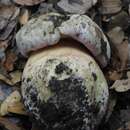en
names in breadcrumbs


Rubroboletus pulchrotinctus is a rare bolete fungus in the genus Rubroboletus, native to central and southern Europe. It was originally described in genus Boletus by Italian mycologist Carlo Luciano Alessio in 1985,[1] but subsequently transferred to genus Rubroboletus by Zhao and colleagues (2015), on the basis of molecular evidence.[2] Phylogenetically, R. pulchrotinctus is the sister-species of the better known Rubroboletus satanas, with which it shares several morphological features.[3]
Rubroboletus pulchrotinctus forms ectomycorrhizal associations with several members of the Fagaceae, particularly species of oak species (Quercus).[4][3]
It is known from Spain,[5] France,[6] Italy[7] and Greece,[8] as well as the Balkan and Crimean Peninsulas.[9][10] In the eastern Mediterranean region, its distribution extends as south as Israel, where it is found in Mount Carmel National Park and Beit Oren growing under the Palestine oak (Quercus calliprinos)[11] and the island of Cyprus, where it is found under the endemic golden oak (Quercus alnifolia).[3]
Rubroboletus pulchrotinctus is a rare bolete fungus in the genus Rubroboletus, native to central and southern Europe. It was originally described in genus Boletus by Italian mycologist Carlo Luciano Alessio in 1985, but subsequently transferred to genus Rubroboletus by Zhao and colleagues (2015), on the basis of molecular evidence. Phylogenetically, R. pulchrotinctus is the sister-species of the better known Rubroboletus satanas, with which it shares several morphological features.
Rubroboletus pulchrotinctus forms ectomycorrhizal associations with several members of the Fagaceae, particularly species of oak species (Quercus).
It is known from Spain, France, Italy and Greece, as well as the Balkan and Crimean Peninsulas. In the eastern Mediterranean region, its distribution extends as south as Israel, where it is found in Mount Carmel National Park and Beit Oren growing under the Palestine oak (Quercus calliprinos) and the island of Cyprus, where it is found under the endemic golden oak (Quercus alnifolia).
Capel fin a 20 cm, feltrà peui pla, reusa lila, piturà an vers ël bòrd, peui grisastr, òcra ciàir o crema al disch. Tùboj giàun motobin viv peui un pòch verd bluastr an testa. Përtus giàun peui giàun groson, un pòch bleu a la pression. Gamba àuta fin a 13 cm e larga fin a 5 cm, limon ciàir o crema rosastra, dle vire sircondà ëd lila an mes, con un fin retìcol dël midem color. Carn giaunastra, reusa lila sota ël capel, un pòch ambluenta, dossa.
A chërs sota latifeuje.
![]() A venta mai mangé un bolè trovà se un a l'é nen un bon conossidor dij bolè!
A venta mai mangé un bolè trovà se un a l'é nen un bon conossidor dij bolè!
A peul esse velenos.
Capel fin a 20 cm, feltrà peui pla, reusa lila, piturà an vers ël bòrd, peui grisastr, òcra ciàir o crema al disch. Tùboj giàun motobin viv peui un pòch verd bluastr an testa. Përtus giàun peui giàun groson, un pòch bleu a la pression. Gamba àuta fin a 13 cm e larga fin a 5 cm, limon ciàir o crema rosastra, dle vire sircondà ëd lila an mes, con un fin retìcol dël midem color. Carn giaunastra, reusa lila sota ël capel, un pòch ambluenta, dossa.
AmbientA chërs sota latifeuje.
Comestibilità![]() A venta mai mangé un bolè trovà se un a l'é nen un bon conossidor dij bolè!
A venta mai mangé un bolè trovà se un a l'é nen un bon conossidor dij bolè!
A peul esse velenos.